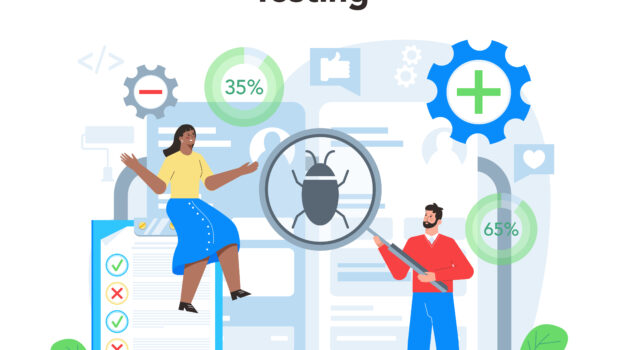Innovative Automation Testing Strategies for IT Enterprises
Innovation automation testing in IT enterprises is essential to determine the quality and performance of the software. With automation embedded in the testing practices, manual efforts on scripting are eased.
For instance, unit testing through manual measures will consume a lot of your QA resources, for which it is the perfect candidate for implementing it with an automation testing strategy. Ultimately, automation in software testing enhances the overall quality of the software.
The budding IT enterprises are now willing to leverage the potential of automation testing to speed up the time-to-market for their software while considering a fine-tuned performance. But, there are certain challenges that are obstructing their way to getting the most out of automation testing.
Some of these challenges include finding the right tool, identifying a strategy, high initial investment, finding the skills, and others. But, there are strategies that you can impose onto your automation testing practices to overcome the challenges and get along with deriving the best version of your software. Read this article till the end to implement those strategies.
Understanding the Landscape of Automation Testing
The entire journey of automation testing has evolved immensely since the era of software testing came into play. Before automation, organisations had to spend a lot of their resources to meet the quality requirements post-tests. But, with the advanced automation testing landscape, the complexities are well attended, and software testing is now simplified.
So, what does the test automation landscape hold for IT enterprises? It has an array of tests that can be automated to derive the true performance of software, which includes:
1. Unit Test Automation
Automated testing can’t be completed without the use of unit testing approaches. Functional testing of software determines what are the errors within the software’s performance, whereas the unit tests count on specifying how the problems are caused in the first place.
The scripts for the unit tests are written by developers without any special coding skills. After automating the execution of these test scripts, you will get consistent insight into the health of your software’s codebase. Unit tests give you immediate feedback on what’s going on with the code.
Thus, it helps you to confirm if the code is performing tasks as it is supposed to. Properly written and executed unit tests won’t trigger false positives. In automation testing, unit tests will get you the most sophisticated results.
2. Integration Test Automation
Integration testing is the approach where the independent system components are tested among each other. Even though these components are independent, they are still interconnected by some means. For instance, imagine a database layer is independent of its functional code. Still, the code and the database layer ultimately need to work together to ensure the changes invoked by a user are reflected within the database.
Therefore, proper integration testing automation is necessary for even the simplest applications. Most modern projects rely on third-party components and integrations, including content delivery networks, data layers, load testing, email services, etc.
The overall demands from this testing differ from one integration to the other. But, it is critical for all integrations to function as per expectations. It is particularly when new builds or changes are implemented. API integration testing is one of the crucial parts of the test automation landscape. It focuses on determining the ability of your software to integrate with other third-party APIs.
Beyond these two tests, there are load test, functional test, regression test, mobile test, and crowd test automation feasibility that are part of its landscape. Unit and integration testing is a priority, but everything else collectively ensures a software’s performance quotient.
Why Do We Need Automation Strategies for IT Enterprises?
Without the test automation strategies, you will have a lack of vision toward how to define the long-term goal for your business. You will bring the wrong technology or tools for the process, which will extend the testing process and affect your overall productivity.
Moreover, automation in software testing will enhance the proper risk analysis attributes to predict the risk involved in the process. There’s a very evident list of reasons you need to implement automation strategies for IT enterprises to test their software with utmost proficiency. Some of those reasons include:
1. Better Workflow Efficiencies
Reducing enterprise costs and the time involved in executing operational activities will lead to enhanced workflow efficiencies. Automation is meant to take optimal care of monotonous or recurring tasks. It will help your employees to drive their focus toward other core business processes. With test automation strategies, your enterprise will be bagging more productivity with fewer efforts.
2. Consistency and Accuracy in Operations
One of the major drawbacks of manual testing is the possibility of errors that you will be coming across during or after the process. Humans might make errors because of the inconsistency in manual processing and the high volume of test cases. There is a possibility that your manual QA analyst might miss out on some steps. But, with automation, that isn’t the case at all. The chances of errors are eliminated.
3. Cost Effective
The entrepreneurs out there consider automation as a strategic investment and not an expenditure. After the initial costs of implementation, business process automation seems to enhance productivity in the long run. Software testing automation takes care of redundant activities, which reduces the need for extensive labour. It minimises maintenance costs, overhauling, and paperwork expenses.
Best Practices to Build Automation Testing Strategies for IT Enterprises
Some of the best practices that you can implement in order to build your perfect automation testing strategies are:
1. Define the Goals
Before you get along with test automation, you should be clear about your short-term or long-term test goals. You should clearly put up the road map and discuss it with the higher stakeholders or management. You should understand your scope of automation, the expected ROI from the process, and the need for it.
2. Planning the Test Approach
There are various levels of testing, and many times, end-to-end testing is confused with automation. But, there are multiple levels for which the best approach is test pyramids. In the test approach planning, you need to follow the order of unit testing, integration & API testing, UI testing, and end-to-end testing. Some other tests that should be part of your plans include cross-browser and cross-platform testing.
3. Choose a Framework
The next step is to choose an automation framework. Discuss with the team and choose the right one to accommodate your functionalities. You can choose among linear automation framework, data-driven test framework, keyword-driven framework, page object model, or others.
4. Choose the Right Tool
The tool you choose should be evaluated to fit your software testing goals within the organisation. You can check with the supported browsers or platforms, cost, expected functionality, programming language support, etc.
5. Pick the Test Automation Environment
Be clear about where the automation test will be executed and how the test data will be stored.
6. Create, Execute, and Maintain the Automation Tests
As you have chosen the tool and technology, you can now create the automation scripts, decide upon what needs to be tested automatedly, and start with quick wins or critical features.
Conclusion
Test automation is one of the only ways for you to efficiently run software testing and derive the performance discrepancies in them. Enterprises all around the world are adopting automation solutions across all departments to streamline business operations. Software testing is one such arena that is leveraging the benefits of automation. You need a strategic approach to overcome the limitations of adopting it, and the steps above will help you.
Cover Image by Freepik















